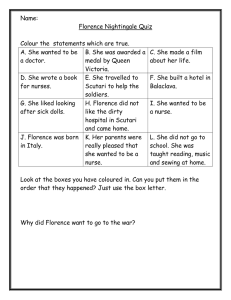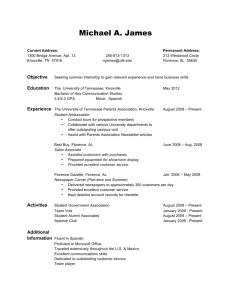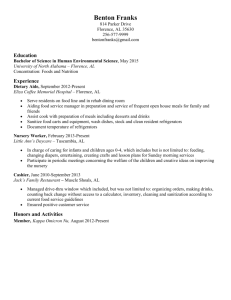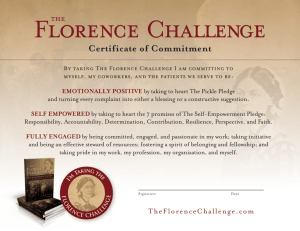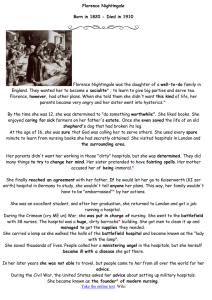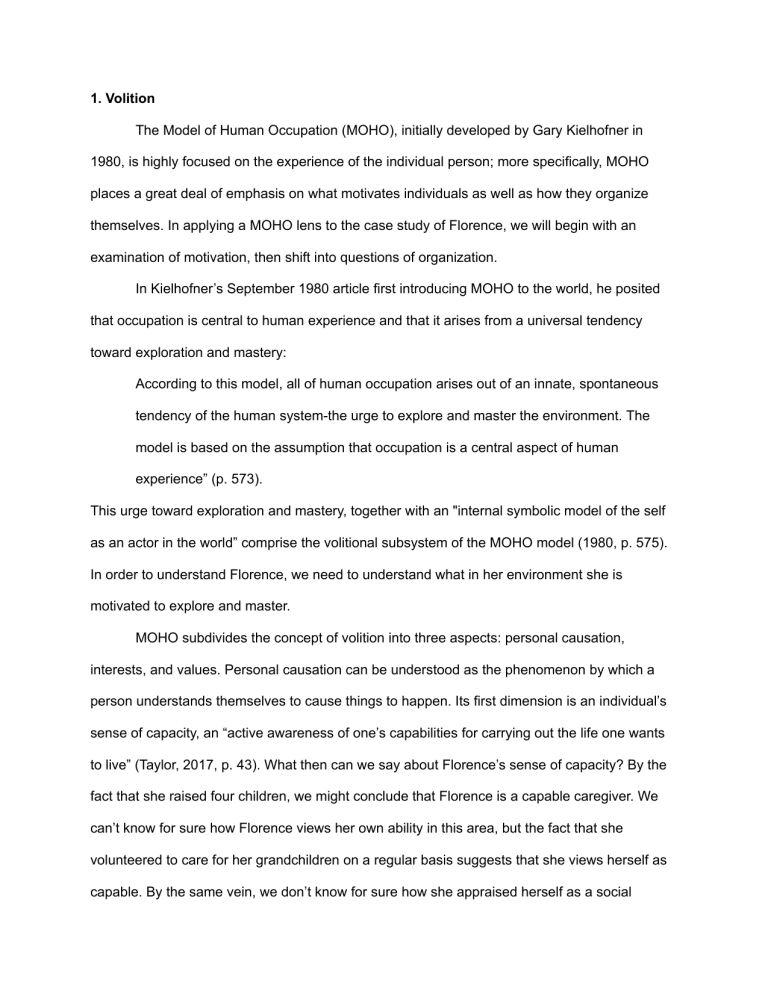
1. Volition The Model of Human Occupation (MOHO), initially developed by Gary Kielhofner in 1980, is highly focused on the experience of the individual person; more specifically, MOHO places a great deal of emphasis on what motivates individuals as well as how they organize themselves. In applying a MOHO lens to the case study of Florence, we will begin with an examination of motivation, then shift into questions of organization. In Kielhofner’s September 1980 article first introducing MOHO to the world, he posited that occupation is central to human experience and that it arises from a universal tendency toward exploration and mastery: According to this model, all of human occupation arises out of an innate, spontaneous tendency of the human system-the urge to explore and master the environment. The model is based on the assumption that occupation is a central aspect of human experience” (p. 573). This urge toward exploration and mastery, together with an "internal symbolic model of the self as an actor in the world” comprise the volitional subsystem of the MOHO model (1980, p. 575). In order to understand Florence, we need to understand what in her environment she is motivated to explore and master. MOHO subdivides the concept of volition into three aspects: personal causation, interests, and values. Personal causation can be understood as the phenomenon by which a person understands themselves to cause things to happen. Its first dimension is an individual’s sense of capacity, an “active awareness of one’s capabilities for carrying out the life one wants to live” (Taylor, 2017, p. 43). What then can we say about Florence’s sense of capacity? By the fact that she raised four children, we might conclude that Florence is a capable caregiver. We can’t know for sure how Florence views her own ability in this area, but the fact that she volunteered to care for her grandchildren on a regular basis suggests that she views herself as capable. By the same vein, we don’t know for sure how she appraised herself as a social worker, but the fact that she stayed in the role for four decades suggests she achieved a level of mastery. The second dimension of personal causation is self efficacy, which involves a strong sense of self control (over one’s emotions, thoughts, decisions and actions) as well as the sense that one’s efforts are adequate to achieve desired results (Taylor, 2017, p. 44). Florence demonstrated high self-efficacy when she persevered to achieve her OT goals around energy conservation and breathing techniques. The fact that Florence practiced the skills daily, in spite of the difficulty she experienced, speaks to her capacity for self control. We can imagine that this experience may have led Florence to feel that she has some control over her situation. The second component of volition is values, which in the MOHO context encompasses both personal convictions as well as a sense of obligation. The former can be understood as beliefs or strongly-held world views, while the after is a sense of being bound to act in a particular way (Taylor, 2017, p. 46). We see hints of Florence’s values in her career choice, family commitments, and day-to-day activities. Social work is often considered a profession that people enter due to personal passion and a desire to be of service, rather than high earning potential or social status. We know that Florence follows organic gardening principles, which are often more labor intensive and lower-margin than non-organic practices. From these two examples, we might conclude that Florence believes in principles such as the common good and caring for vulnerable members of society, and stewarding the natural environment. While many individuals attend church for reasons other than personal spiritual convictions, Florence’s participation gives reason to believe she might follow a religious code. Though the word “obligation” might not necessarily resonate, Florence has shown an enduring commitment to the well-being, growth and development of her grandchildren. The final volitional component is interests, from which flow pleasure and satisfaction. We know that Florence enjoys both reading and crocheting, and that she delights in the bond she has with her grandchildren. Though unstated, we may reasonably assume the reason she bothers to exert the effort to garden, meet friends for lunch, and plan a trip abroad is because she derives pleasure from these activities. We didn’t receive explicit information about Florence’s mental health, so we can’t make conclusive statements about her emotional status, but at a minimum, there was no information given that suggests she is feeling depressed, despondent or disengaged. It seems fair to conclude that her long-term interests, such as time-intensive hobbies and ongoing relationships, support her positive engagement and well being. 2. Roles, Routines & Habits Per the fourth edition of the Occupational Therapy Practice Framework (OTPF-4), performance patterns are one of the key aspects of the occupational therapy domain—along with occupations, contexts, performance skills and client factors—and consist of habits, routines, roles and rituals. The document in fact cites Kielhofner and Taylor as references for its definition of roles as “sets of behaviors expected by society and shaped by culture and context (American Occupational Therapy Association, 2020). Florence’s roles include mother/grandmother/caregiver, farmer/gardener, churchgoer (possibly Christian and/or person of faith), homeowner/landowner (possibly homesteader), retiree, and friend, among others. MOHO presents occupational identity as “a composite sense of who one is and wishes to become as an occupational being generated from one’s history of occupational participation” (Taylor, 2017, p. 117). According to this definition, we should consider Florence’s occupational identity to include not only her present status in roles listed above, but also her history of occupational participation, which included, for example the role of social worker. In considering how Florence might describe her sense of who she has been, is, and wishes to become, the words “independent” and “persistent” seem salient. She resisted the suggestion that she move in with her daughter, choosing instead the path of remaining in her own home, and the accompanying challenges. Occupational competence involves sustaining a successful pattern of occupational participation that reflects one’s occupational identity (Taylor, 2017, p. 117). Florence’s occupational competence was thrown into question when her COPD symptoms became to interfere with daily functioning, precipitating her daughter’s suggestion that she relocate from her home. In response, Florence mobilized herself to leverage OT as an opportunity to re-establish occupational competence both in her own self concept, as well as in the eyes of her family. The OTPF-4 summarizes the domain and process of occupational therapy with the overarching statement, “Achieving health, well-being, and participation in life through engagement in occupation” (American Occupational Therapy Association, 2020). The World Health Organization classifies participation as “‘involvement in a life situation’ or ‘the lived experience’ of people in the actual context in which they live” (2008). Florence does indeed engage in work, play, and activities of daily living that are part of her sociocultural context and that are desired and/or necessary to her well-being (Kielhofner, 2009, p. 153). Leisure occupations are described above in the sixth paragraph of section 1 - Volition. Her participation further includes occupations in the categories of IADLs (e.g. community mobility, meal preparation and cleanup), health management (e.g. symptom and condition management for COPD), rest and sleep, leisure, and social participation (e.g. friendships). In MOHO, “occupational performance” refers to the “discrete acts, or units of doing, that are performed” (Taylor, 2017, p. 107). Each of the occupations described above can be further broken down into activities and tasks that are necessary for completion. In Florence’s case, once adaptations were put into place and she became comfortable with new patterns of engagement, her performance was generally adequate to meet the demands of the environment. However, there is one example that stands out in which she does not have the adequate skill; namely, she falls asleep on the couch some evenings because she lacks the stamina at the end of the day to ascend the stairs to her bedroom. In so far as sleeping on the couch may not be ideal from an ergonomic or safety standpoint, it would be better if Florence either increased her motor skill in this area, or made an adjustment to her nightly routine. Other types of skills, in addition to motor skills, include process skills and communication and interaction skills. Florence is currently strong in these areas. All in all, Florence’s volition, habituation and performance capacity are intact and functioning at a high level, post-occupational therapy. A major constraint of Florence’s environment is the fact that she lives alone, and is thus caring for not only herself, but also her home and outdoor environs. Fortunately, she also has resources that exert a positive influence on her situation and how she thinks, feels and acts. These include the fact that she has help from her daughter and grandchildren, who help her in practical ways and also lift her spirits. Though we don’t have detailed information on her financial resources, we presume that she owns her home and land, and may have discretionary income, e.g. that she is using for international travel. She was able to access occupational therapy services, which were helpful to her. As mentioned above, living alone places a significant demand on Florence to complete her self care ADLs as well as IADLs such as meal prep and cleanup. We do not have detailed information on the exact type of help her daughter and grandchildren provide, e.g. whether they do all of the grocery shopping, whether they clean the house, do laundry, yard work, etc. With the awareness that Florence requires portable oxygen to engage in strenuous activities, it would be wise to consider these occupations (and others) in planning for supports necessary to enable her to age in place. 3. Performance Capacity As described above in the 6th paragraph of section 2 - Roles, Routines and Habits, Florence’s decreased energy in the evenings, which often prevents her from ascending the stairs to bed, is an area of concern. In addition to possible drawbacks of sleeping on the couch, there is the question of whether she is truly safe on the stairs on those nights that she does go upstairs; are her “good days” truly good, or are there nights when she is exhausted and at risk of a fall? Is her condition stable, or is her functional activity tolerance declining? Whether or not her condition is currently stable, COPD is a progressive disease, and it is reasonable to assume that her performance capacity in the area of functional mobility in the home will be an area of concern in the future. 4. Skills See paragraphs 5 and 6 in Section 2 - Roles, Routines & Habits, which discuss Florence’s skills and problems in detail. 5. Environment See paragraphs 8 and 9 in Section 2 - Roles, Routines & Habits, which provide an introduction to Florence’s environment. As mentioned previously, Florence experiences difficulty ascending the stairs and functional mobility is a concern for the future. Her physical environment has limitations, not the least of which is the lack of a first floor bedroom. It may be advisable in the future to convert the first-floor den to a bed room, or, alternately, install a stair lift. Her social environment is supportive, and her occupational environment is relatively stable post-occupational therapy. We have focused here primarily on Florence’s immediate context, which is her home, but of course, she is also embedded within local and global societal contexts. She lives on a small farm, which suggests she is located in a rural area. This may mean that there are greater distances between residences and community spaces. Rural areas also tend to afford less public transportation, which could present a difficulty for Florence at a later date if she stops driving. While the above represent challenges in Florence’s environment, there are also enabling resources present. Her grandchildren’s enthusiasm for play may encourage her to engage in moderate activity. The need of garden to be watered, weeded, etc. may encourage her to spend time outdoors, and the expectation of her customers to have food at the stand may encourage her to stick with gardening despite challenges. 6. Occupational Identity, Competence and Adaptation See the second and third paragraphs of section 2 - Roles, Routines & Habits paragraphs for discussion of occupational competence. Given that Florence demonstrates an overwhelmingly positive occupational identity and has grown in her occupational competence through the adjustment process following diagnosis, her occupational adaptation to date has been strong. 7. Continuum of Change Within the Model of Human Occupation, change is viewed as inevitable. As Taylor (2017) puts it, “The course of any life involves ongoing incremental and ongoing change” (p. 148). Though not catastrophic in scale, the change that Florence has experienced has certainly transformed many aspects of her daily living and occupational engagement. We can imagine her pre-COPD as someone who had perhaps slowed down some, but was living an active lifestyle in many respects. Caring for young children is often physically taxing, as is maintaining a garden that yields enough produce to sell. With the onset of symptoms and the COPD diagnosis, Florence was forced to reorganize many facets of her life in order to conserve energy and achieve her desire of aging in place. MOHO conceptualizes change as a process that occurs across a continuum, involving first exploration, then competency, and finally achievement. The first of these stages, exploration, represents a process of self discovery as the individual attempts new patterns of engagement. Competency occurs as individuals consolidate their learning and endeavor to grow in their ability to meet environmental demands. Finally, achievement describes a state of having adequate skills and habits that allow full participation in the new area of occupational participation (Taylor, 2017, pp. 146-147). In some areas of occupational life, Florence has moved through the three stages during her time working with an OT. In the example of gardening, there was presumably an exploratory stage during which Florence had to identify which activities were no longer compatible with her physical limitations, and learn more about compensatory strategies, adaptive tools, etc. The competency stage would have involved solidifying the new ways of gardening, and now she has reached the achievement stage, at which she can garden comfortably in a “new normal” way. In other areas of occupational life, we could say that Florence is still in the exploration stage, or possibly has not even yet embarked upon a change process. As Taylor explains, “...people typically progress through these levels of function when they move into new roles, encounter new environments, and make lifestyle changes, or when they reorganize their lives in response to a major disruptive circumstance or event” (2017, p. 146). We know, for example, that Florence is planning a trip abroad, perhaps the first since her diagnosis. This will thrust her into a new environment and the role of traveler. To what extent has Florence grappled with the fact that her physical decline will impact her experience in navigating an airport terminal with her luggage, or sightseeing? Has she considered the fact that she may be unable to climb flights of stairs, and that this may be a factor in choosing accommodations, etc.? Community mobility may be an occupation for which Florence will soon be entering the exploration phase. References American Occupational Therapy Association. (2020). Occupational therapy practice framework: Domain and process (4th ed.). American Journal of Occupational Therapy, 74(Suppl. 2). https://doi.org/10.5014/ajot.2020.74S2001 Kielhofner, G., Burke, J. P. & Igi, C. H. (December 1980). A Model of Human Occupation, Part 4. Assessment and intervention. American Journal of Occupational Therapy, 34, 777-788. https://doi.org/10.5014/ajot.34.12.777 Kielhofner, G. (2009). Conceptual foundations of occupational therapy practice (4th ed.). F.A. Davis Company. Taylor, R. R. (Ed.). (2017). Kielhofner’s model of human occupation: Theory and application (5th ed.). Wolters Kulwer. World Health Organization. (2008). International classification of functioning, disability and health: ICF. WHO Press.
